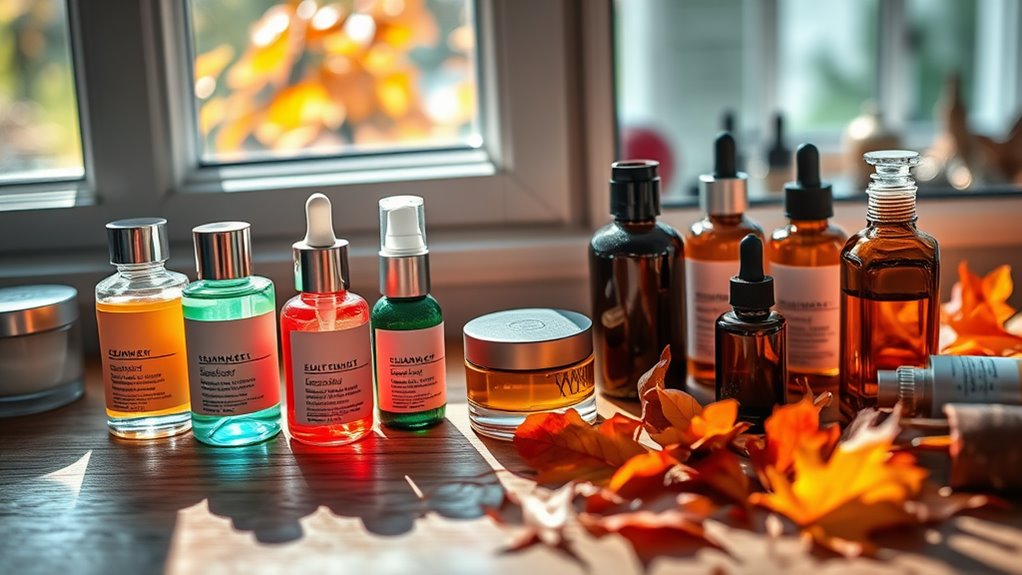Why You Should Change Your Skincare With the Seasons
Just as nature shifts with the seasons, so too should your skincare routine. The changes in temperature, humidity, and environmental factors can significantly affect your skin’s health and appearance. By understanding how these seasonal variations impact your skin, you can adapt your products and techniques accordingly. Discover the essential adjustments you need to make to maintain a healthy, radiant complexion all year long.
Key Takeaways
- Seasonal changes affect skin’s moisture levels, requiring adjustments in hydration to combat dryness or excess oil.
- Different seasons bring unique skin challenges, such as breakouts in spring and dryness in winter, necessitating tailored products.
- Ingredients should align with seasonal needs, using lightweight options in summer and richer formulations in colder months for optimal skin health.
- Regular cleansing routines must adapt, with cream-based cleansers in winter and more frequent washes in humid summer to maintain balance.
- Sun protection is vital year-round, but the type and frequency of application should vary according to seasonal UV exposure.
The Impact of Seasonal Changes on Your Skin
How does the changing season affect your skin?
Each season brings unique challenges that demand adjustments in your skincare routine.
In winter, cold air may strip moisture, leading to dryness and irritation.
Spring can introduce allergens, causing breakouts and sensitivity.
Summer’s heat and humidity often result in excess oil production, increasing the risk of acne.
Fall may trigger dryness again as temperatures drop.
To navigate these fluctuations effectively, consult a seasonal skincare guide, as incorporating seasonal skincare swaps can help maintain healthy, glowing skin year-round.
Key Ingredients for Each Season
What essential ingredients should you incorporate into your skincare routine as the seasons change?
In spring, look for lightweight moisturizers with hyaluronic acid to hydrate without weighing you down. As summer arrives, opt for products with antioxidants like vitamin C to combat sun damage. In fall, switch to richer creams containing shea butter or jojoba oil to replenish moisture. Finally, in winter, focus on nourishing ingredients like ceramides and squalane to protect against dryness. Additionally, consider seasonal skin issues that may arise in different weather conditions to tailor your products effectively.
Adjusting Your Cleansing Routine
As the seasons shift, adjusting your cleansing routine is just as important as selecting the right ingredients.
Different weather conditions can affect your skin’s needs.
Here’s how to adapt:
-
Switch to a gentle cleanser: In colder months, opt for cream-based cleansers to avoid stripping moisture.
-
Increase cleansing frequency: In humid summers, cleanse twice daily to remove excess oil and sweat.
-
Incorporate exfoliation: During transitional seasons, gently exfoliate once or twice a week to promote cell turnover and remove dead skin. Additionally, consider the importance of hydrated skin in winter to maintain a healthy complexion.
Moisturizing for Different Weather Conditions
Moisturizing effectively throughout the year is crucial for maintaining skin health, as different weather conditions can significantly impact hydration levels.
In winter, opt for thicker creams to combat dry air and prevent moisture loss.
During summer, lightweight gels or lotions work best, as they hydrate without feeling heavy.
If you’re in a humid climate, consider non-comedogenic formulas to avoid clogged pores.
For transitional seasons like spring and fall, adjust your moisturizer’s thickness to match fluctuating temperatures.
Always focus on ingredients like hyaluronic acid and glycerin, which attract moisture, ensuring your skin remains plump and hydrated, regardless of external conditions. Additionally, be mindful of whether your moisturizer is too heavy for your skin type, as this can lead to various skin issues.
Seasonal Sun Protection Tips
With changing seasons, adjusting your sun protection strategy becomes just as important as modifying your moisturizing routine.
As seasons change, so should your sun protection strategy—it’s as crucial as updating your moisturizer.
Here are three essential tips to stay protected:
-
Choose the Right SPF: In summer, opt for a broad-spectrum SPF of 30 or higher. In winter, consider a lower SPF, but don’t skip it altogether.
-
Reapply Regularly: No matter the season, reapply sunscreen every two hours, or more often if you’re swimming or sweating.
-
Don’t Forget About Clouds: UV rays can penetrate clouds, so wear sunscreen even on overcast days to protect your skin year-round. Remember, never skip sunscreen as it is your skin’s best defense against harmful UV rays and premature aging.




